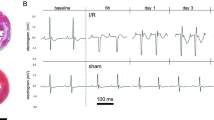Summary
Myocarditis and progression to cardiomyopathy is associated with focal spasm and reperfusion of the coronary microcirculation. Experimental autoimmune myocarditis (EAM), induced with cardiomyosin peptide-specific T cells in Lewis rats, was hypothesized to cause acute hemodynamic and coronary vasculature changes. Fifteen experimental animals (5 each at 1, 2, and 3 weeks after T-cell injection) and eight controls were studied using the constant pressure variant of the isolated heart. Coronary resistance decreased while coronary flow increased (P < 0.05) in EAM hearts after the first week. Rate-pressure product, +dP/dt and −dP/dt, decreased while the heart/body weight ratio increased (P < 0.05) compared with controls at 1 week but not at 2 or 3 weeks. Mean local myocardialPO2, which reflects local oxygen delivery and consumption, and MVO2 were not different for EAM hearts. However, compared with controls EAM myocardialPO2 varied more widely and was often beyond the usual range, suggesting the occurrence of localized hypoxic and hyperoxic areas. In summary, after the first week there was a significant decrease in coronary resistance in the EAM animals, which required higher flow to maintain a similar perfusion pressure. These changes in coronary resistance and flow along with the heterogeneity and extremes of local myocardialPO2 levels without a significant change in MVO2 may be explained by postulating development of low-resistance, high-flow hyperoxic areas which steal flow, thus causing hypoxia in other areas.
Similar content being viewed by others
References
Wegmann KW, Zhao W, Griffin AC, Hickey WF (1994) Identification of myocarditogenic peptides derived from cardiac myosin capable of inducing experimental allergic myocarditis in the Lewis Rat. J Immunol 153:892–900
Kodama M, Matsumoto Y, Fujiwara M, Masani F, Izumi T, Shibata A (1990) A novel experimental model of giant cell myocarditis induced in rats by immunization with cardiac myosin fraction. Clin Immunol Immunopathol 57:250–262
Dong R, Liu P, Wee L, Butany J, Sole MJ (1992) Verapamil ameliorates the clinical and pathological course of murine myocarditis. J Clin Invest 90:2022–2030
Factor SM, Minase T, Cho S, Dominitz R, Sonnenblick EH (1982) Microvascular spasm in the cardiomyopathic Syrian hamster: a preventable cause of focal myocardial necrosis. Circulation 66:342–354
Figulla HR, Vetterlein F, Glaubitz M, Kreuzer H (1987) Inhomogeneous capillary flow and its prevention by verapamil and hydralazine in the cardiomyopathic Syrian hamster. Circulation 76:208–216
Friedman BJ, Grinberg OY, Isaacs K, Walczak TM, Swartz HM (1995) Myocardial oxygen tension and relative capillary density in isolated perfused rat hearts. J Mol Cell Cardiol 27:2551–2558
Swartz HM, Dunn J, Grinberg O, O'Hara J, Walczak T (1998) What does EPR oximetry with solid particles measure and how does this related to other measures of pO2. Oxygen Trans Tissue XIX 428:663–670
Barlow CH, Chance B (1976) Ischemic areas in perfused rat hearts: measurement by NADH fluorescence photography. Science 193:909–910
Ince C, Ashruf JF, Avontuur AM, Wieringa PA, Spaan JAE, Bruining HA (1993) Heterogeneity of the hypoxic state in rat heart is determined at capillary level. Am J Physiol 264:H294-H301
Steenbergen C, Deleeuw G, Barlow C, Chance B, Williamson JR (1977) Heterogeneity of the hypoxic state in perfused rat heart. Circ Res 41:606–615
Esaki T, Hayashi T, Asai Y, Kumar TN, Kano H, Muto E, Iguchi A (1997) Expression of inducible nitric oxide synthase in T lymphocytes and macrophages in vessels with advanced atherosclerosis. Heart Vessels Suppl 12:89–92
Hirono S, Islam O, Nakazawa M, Yoshida Y, Kodama M, Shibata A, Izumi T, Imai S (1997) Expression of inducible nitric oxide synthase in rat experimental autoimmune myocarditis with special reference to changes in cardiac hemodynamics. Circ Res 80:11–20
Moncada S, Higgs A (1993) The L-arginine-nitric-oxide pathway. N Engl J Med 329:2002–2012
Herzum M, Weller R, Jomaa H, Wiertrzychowski F, Pankuweit S, Mahr P, Maisch B (1995) Left ventricular hemodynamic parameters in the course of acute experimental coxsackievirus B 3 myocarditis. J Mol Cell Cardiol 27:1573–1580
Kotaka M, Kitaura Y, Deguchi H, Kawamura K (1990) Experimental influenza A virus myocarditis in mice. Light and electron microscopic, virologic and hemodynamic study. Am J Pathol 136:409–419
Rubboli A, Sobotka PA, Euler DE (1994) Effect of acute edema on left ventricular function and coronary resistance in the isolated rat heart. Am J Physiol. 36:H1054-H1061
Masuda M, Chang-Chun C, Cho BC, Flameng W (1994) Coronary reserve and contractile reserve in crystalloidand blood-perfused rabbit hearts. Heart Vessels 9:175–182
Friedman BJ, Grinberg OY, Grinberg SA, Swartz HM (1997) Myocardial oxygen tension in isolated erythrocyte-perfused rat hearts and comparison with crystalloid media. J Mol Cell Caridol 29:2855–2858
Author information
Authors and Affiliations
Additional information
This work was supported by AHA, New Hampshire Affiliate Grant-in-Aid 9407770S, and NIH Grant Program Project GM 51630, and made use of the EPR Center at Dartmouth Medical School which was supported by NIH Grant RR 11602.
Rights and permissions
About this article
Cite this article
Friedman, B.J., Grinberg, O.Y., Ratcliffe, N.R. et al. Acute hemodynamic and coronary circulatory effects of experimental autoimmune myocarditis. Heart Vessels 13, 58–62 (1998). https://doi.org/10.1007/BF01744587
Received:
Revised:
Accepted:
Issue Date:
DOI: https://doi.org/10.1007/BF01744587




